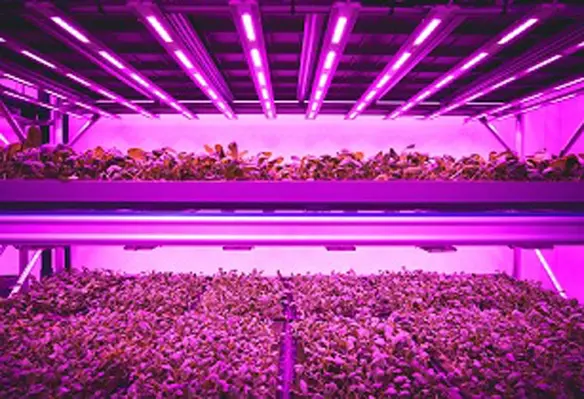Vertical farming is increasingly being regarded as one of the solutions to the problems faced by global food production systems
Bringing agricultural production indoors resolves many of the challenges the world faces, including unsustainable harm to the environment and biodiversity; greenhouse gas emissions and water usage; seasonal availability and global market demand; and climate change. For example, crops can be provided with ideal growing conditions, whatever the season, while being protected from variations in the weather. Water can be recycled, and pesticides are almost completely unnecessary. With no soil or pesticide contamination, water efficiency is further enhanced by the absence of a requirement for washing.
Traditionally, greenhouses and hydroponics have offered solutions to many agricultural problems, but with urbanisation and the high cost and low availability of land in urban areas, it is difficult to resolve the food miles challenge.
Vertical farming dramatically reduces the physical footprint of food production, but given the high cost of energy, it is vitally important for the financial sustainability of vertical farming that it operates as efficiently as possible. For this reason, sensors perform a critical role, which is why Vaisala sensors have been deployed in the UK by the Jones Food Company (JFC) in their existing vertical farms, and in the enormous new facility in Lydney (JFC2) that is likely to become one of the largest vertical farms in the world.
Case Study – large commercial vertical farm in the UK: JFC2
JFC was established in 2016 to exploit the advantages of vertical farming to provide fresh local produce all year round. The company’s first commercial vertical farm (JFC1) started production in 2018 with 5,000 sq m of growing space and the capacity to produce 150 tonnes per year of fresh produce. JFC2 will be much larger with a growing area of 15,000 sq m with a growing capacity of 1000 tonnes per year. The key aspects of the company’s approach that underpin commercial sustainability include:
1. Scale – large facilities provide an economy of scale along with the capacity to satisfy large orders.
2. Technology – in order to create and maintain ideal growing conditions, it is necessary to implement highly effective monitoring and control systems.
3. Re-purposed facilities – rather than incur the high environmental and financial cost of a new-build, JFC has actively sought large redundant buildings. JFC2 for example, was previously a foundry.
4. Innovation – a research facility has been established to trial new crops and different growing conditions. Again, accurate monitoring and control is vital.
JFC’s Innovation Centre in Bristol has the capacity to trial ten different crops under different conditions, concurrently. “This is fundamentally important to the success of the business,” explained Justin Au, operational grower, JFC. “When a customer approaches us looking for a specific crop, we are able to rapidly conduct trials to determine the optimal growing conditions for that crop, and at every stage of its development. The monitoring and control system allows us to change both the intensity and spectra of light from the LEDs, as well as the nutrients in the irrigation water, and the temperature, humidity and carbon dioxide levels in the growing rooms.
“Once the optimal conditions have been established for a specific crop, we can be confident that we will be able to grow it at scale, and fulfil the customer’s requirements. Our objective is to drive efficiency so that we can compete with existing on-shelf products but with the substantial sustainability advantages that vertical farming delivers.
“Currently, we are growing herbs such as basil, dill, parsley, coriander, mint and chives; salads such as lettuce, rocket, pak choi, spinach, chard, kale and watercress, as well as other crops such as strawberries. Inevitably, the range of crops that we can grow commercially with vertical farming will continue to expand.”
Water is constantly recycled at all of the JFC facilities with continuous measurements of pH and conductivity helping to ensure the regulation of plant nutrients with dissolved fertilizers. The Vaisala sensors measure temperature, humidity and carbon dioxide; all of which have significant impacts on the growth of plants. “We chose the Vaisala sensors because we need long-term accuracy and reliability, and the control system can only be as good as the sensors, so it makes sense to use the best.” Au said.
The first harvest for JFC2 is due in the summer of 2023, and with 15 layers, every acre becomes 15 times more productive. The roof of the new facility is entirely covered with solar panels, and 100% of energy will come from renewable sources. Rainwater will be harvested and filtered, and almost 95% of water will be recycled.
In order to maximise the efficiency of growing conditions in JFC2, the entire facility will be monitored by a network of Vaisala sensors including: 46 RH/Temp sensors; 12 CO2 sensors; 10 Temp/RH/CO2 sensors; 2 atmospheric pressure sensors, and a Vaisala WXT 530 series multiparameter weather station.
Summary
The principal advantages of vertical farming over traditional methods almost all relate to sustainability. Space is used efficiently to accommodate an urban setting where necessary, and to lower food miles. Importantly, fresh produce can be available on any day of the year, no matter what the weather or season. However, escalating food production costs mean that the success of new vertical farms will hinge on their ability to monitor and control inputs effectively, which is why sensor quality is so important.





